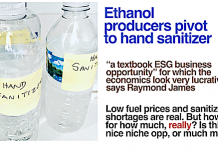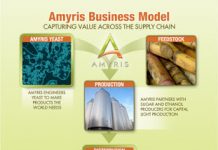by Debra Fiakas CFA
This week the last reminder of the renewable fuels business that was once called Solazyme will be gone. The old Solazyme has abandoned the goal of producing renewable fuels using the oils from algae. Instead, under a new name TerraVia, the company is directing its algae cultivation and harvesting knowhow toward growing edible algae for food and personal care products. To make the change complete the old stock symbol ‘SYZM’ gives way this week to a new trading symbol ‘TVIA.’
No doubt there is more than just a little hope in Terra Via’s boardroom that investors will forget the many troubled years trying to wring diesel fuel from algae. According to the last annual report, Solazyme took in $585.7 million in equity capital to bankroll its algae-to-fuel tank business plan. There is also $202.5 million in convertible debt that will need to be paid off or converted. Unfortunately, its operations reported $609.9 million in losses since inception, leaving the company with a $46.5 million deficit. It is going to take quite a bit of fancy algal fudge to fill that gap.
Of course, there are numerous food products that could be developed based on nutritionally rich algae. Algae is about 50% protein has about as much protein as rice or peas. In September 2015, the company introduced an algae protein product called AlgaVia that contains 64% protein along with other good-for-you elements such as fiber and amino acids. Microalgae are used to convert sugars into oils and proteins. The mature microalgae are then harvested, washed, dried and milled into a fine powder. The company touts the value of the powder for ready-to-drink beverages, sauces, or baked goods. A cracker, for example, made with AlgaVia could have twice the amount of protein.
In early May 2016, TerraVia announced a deal with Bunge Ltd. (BG: NYSE) to launch a line of sustainable specialty feed ingredients. The joint venture is going after the aquaculture market first with a whole algae product called AlgaPrime DHA. A supply agreement has already been worked out with a large aquaculture feed supplier, but Terra Via has kept quiet on the terms. However, the company did suggest that the supplier would begin lacing its fish feed with AlgaPrime beginning yet in 2016.
Make no mistake TerraVia has not given up on commercial grade algal oils. Unilever has chosen the company’s oils for its Lux soap. Algal oils have great public relations value. Unilever’s Lux is vegan and petroleum-free, providing Unilever with marketing value to reposition this time honored product.
TerraVia also has its own personal care product line. The cosmetics retailer Sephora S.A. is distributing TerraVia’s Algenist line of anti-aging and color correcting products. QVC with its multimedia marketing platform and ULTA Beauty stores also sell the Algenist line.
There is also a strong sustainability argument to make for tapping algae for use in the human and animal food complex. The large quantities of land, water and fertilizer needed for field crops are unnecessary for algae cultivation. Algae can be grown in what many call ‘reactors’ with a much smaller footprint than are required to harvest the equivalent amount of protein from grain crops. (Personally, I hope edible algae producers come to their senses and change this name as well. Who really wants to eat something from a reactor?)
The enthusiastic case for algae does not appear to have been a comfort for TerraVia investors disillusioned over the company’s continued losses. The stock has steadily traded down from a 52-week high of $3.73 set in May 2015. Of course, some shareholders might remember the company’s initial public offering in 2011, after which the stock traded up to an all-time high of $26.31.
So far the Unilever deal may offer the most promise for significant revenue. TerraVia has agreed to supply at least 10,000 metric tons of algal oil for use in Unilever’s Lux soap and other personal care products. Some have valued the supply deal at $200 million over the next few years. The key to whether the shipments will generate a profit for TerraVia hinges on products yields. TerraVia plans to produce the algal oil for Unilever in a facility in Brazil constructed jointly with Bunge Global Innovation next to Bunge’s sugar cane processing plant. After beginning construction in 2012, the plant came on line in 2014 and reach full capacity in 2105.
Bunge provides the sugar-cane based sucrose for TerraVia’s hungry algae. Corn feedstock might be an alternative. Thus production costs for the company’s algal oils are likely to be highly dependent upon sugar and corn commodities. Sugar prices have recovered from lows set in 2015, but still remain well below highs set in early 2011. TerraVia’s production for Unilever may get off to good start with relatively economical sugar ‘feed’ for its algae. Coupled with production of algae for the AlgalPrime DHA product that TerraVia is producing in another joint venture with Bunge, TerraVia may be moving nearer a profitable production level.
It is not likely that shareholders will be long distracted by name changes. Solazyme or TerraVia. Fuel or fudge. Like always shareholders are looking for performance. The next financial reports from TerraVia may need to offer clear evidence of commercial progress.
Debra Fiakas is the Managing Director of Crystal Equity Research, an alternative research resource on small capitalization companies in selected industries.
Neither the author of the Small Cap Strategist web log, Crystal Equity Research nor its affiliates have a beneficial interest in the companies mentioned herein.








